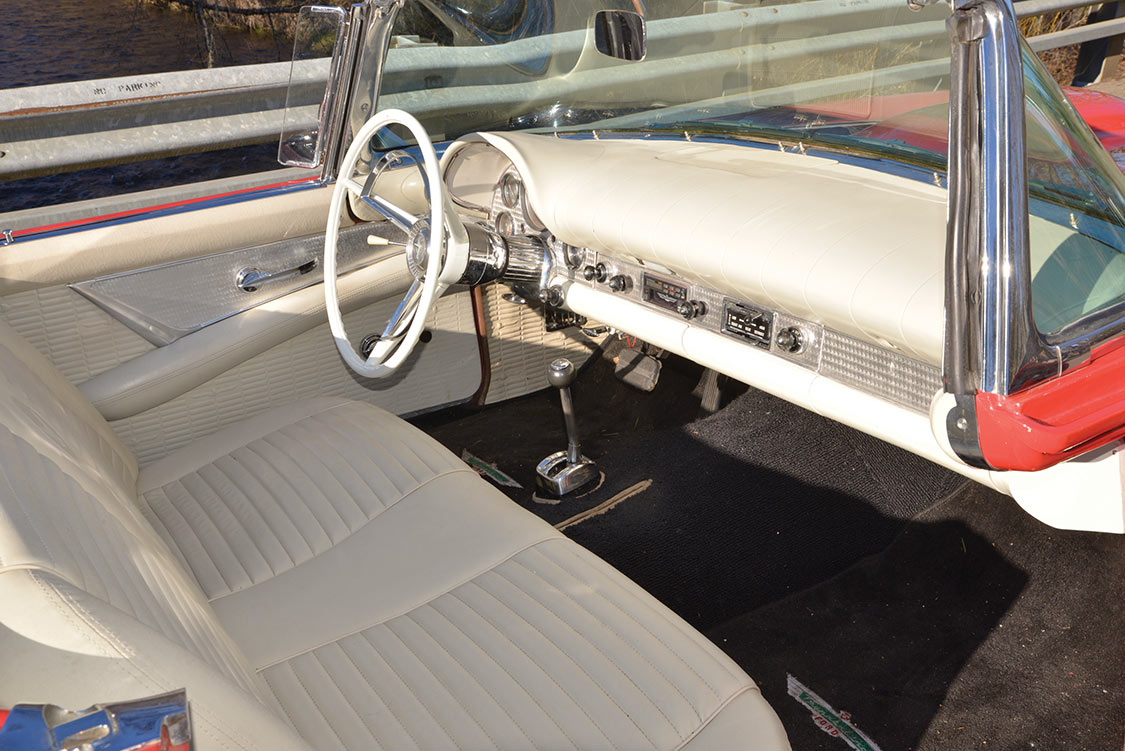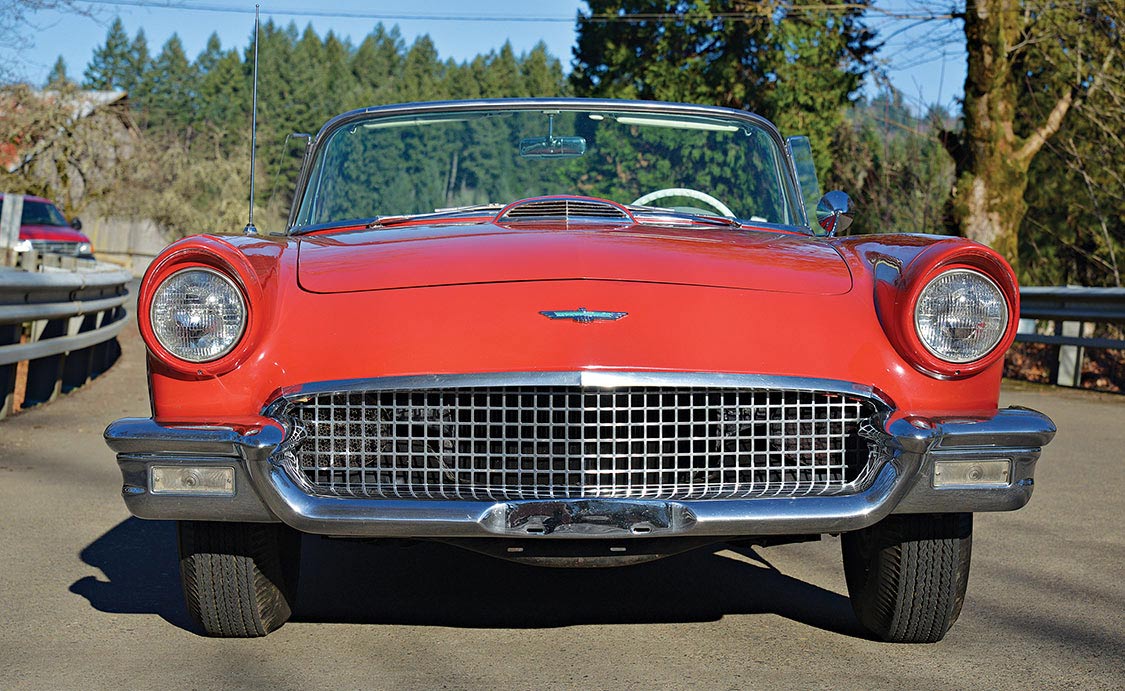 Dan Burrill
.
February 08, 2023
.
All Feature Vehicles
Dan Burrill
.
February 08, 2023
.
All Feature Vehicles

Over the past 20-years, As a young man growing up in the late 1960s, Bob Olds had a bucket list of the desirable cars he wanted to own, that is, when finances would finally allow it.
“The mid-50s Ford Thunderbird was one car that spent a long time on that list,” said Bob. “Then this car became available, the timing was right, and the wait was worth it.”
The car has only 51,000 original miles on it and it has never been wrecked or had any restoration work done.

This 1957 model was the last year of a three-year production run of the sporty two-seat convertible. The car has only 51,000 original miles on it and it has never been wrecked or had any restoration work done. Somewhere along the line, the factory porthole hardtop disappeared, but everything else is present and accounted for, and for its age, the car really is in pretty good shape. Ironically, the porthole hardtop was standard issue with the car, and the convertible top, which came with the car, was an option.
“Of the 1955 through 1957 T-Birds, this was always my favorite,” said Bob. “This is the year Ford came out with the long sweeping lines and the slanted tailfins.”
The car has the factory red exterior with the white interior. The bench seat is standard and bucket seats were not an option. For a long time this car was on display at a Casino, until it was finally raffled off to a lady who drove it for a short while and decided she liked the newer, more modern cars better than this trip down nostalgia lane.
As soon as Bob became aware that the car was now available, he immediately made the obligatory phone call, got directions and drive up to the lady’s home, towing his trailer. After some discussion, the deal was made, the car was loaded on the trailer, and he was on his way.
“You don’t have a lot of bargaining power when you show up towing a trailer,” Bob said with a laugh. “But it was a fair deal and it all worked out in the end.”
During the drive we noticed that the 3,288 -pound Thunderbird handled well.

Bob has a very nice place in the country where he has an interesting eclectic car collection that ranges from a rare GTO to an equally rare Avanti. After much conversation about the car and some of the other cars in his collection, we finally got around to driving it. During the drive we noticed that the 3,288 -pound Thunderbird handled well. This is due in part to the T-bird’s good front to rear weight ratio, and the fairly short Wheelbase – 102 inches. The soft but decent suspension tuning also played into it. The front suspension uses unequal length upper and lower control arms with coil springs and the rear suspension is perched on leaf springs. The steering is worm and roller and works quite well. The car sits on 14-inch tires and has 11-inch drum brakes front and rear.

Performance with the Y-block 312 cubic inch V8 engine was good. This particular engine has the 4-barrel carburetor, and produces 245 horsepower, along with an impressive 332 pound-feet of torque. The transmissions is the three-speed automatic. As Ford’s “personal luxury car,” the T-Bird makes a much better cruiser than the other sports cars of its day.
Considering its age, this is a comfortable, smooth-riding vehicle. As we mentioned, performance and handling were good and, let’s face it – cruising around in a classic convertible on a warm day, on a country road with no traffic, is hard to beat.
In January 1953 Chevrolet unveiled a new prototype sports car, named the Corvette. In a panic, Ford jumped on the bandwagon and within a year the Thunderbird went from the boardroom to the design table to an actual prototype. The original prototype was done just in time and first appeared at the 1954 at the Detroit Auto Show.
Had it not been for Chevrolet jumping into the sports car market with their fiberglass-bodied Corvette, the conservative brass at Ford probably never would have come out with the original Thunderbird.
Taking a hard look at the market, and wanting to get into production as fast as possible, Ford used as many existing parts as possible on this new sporty car. Ford determined that the best way to market the T-bird was to make it more comfortable than the austere Corvette and present it to the public as the new “personal luxury car.”
By 1957, the third year in production, Fords list of options for the little ‘Bird was staggering. The list included power windows, power steering, power brakes, and power seats. At this point, those that were looking for comfort came to Ford, and those that were looking for performance were buying the Corvette.
As always, the American car buying public is more interested in creature comforts than austere performance sports cars, which is one of the reasons that the Thunderbird did so well, outselling the Corvette during the 1955 through 1957 years.
Sales for 1957 were the best of the three-year run, with 21,380 cars going off the showroom floor. All totaled, during the three-year production run there were 53,160 two-seat Thunderbirds sold. Today, in good condition, these cars are considered a highly sought-after classic, although there is really no shortage of the two-seat Thunderbirds. Prices are all over the map depending on condition.
Not content to leave a good design alone, for 1958 Ford changed the design and added two more seats. Now fast forward forty-years. The last 4-seat Thunderbird was produced in 1997, but by then they had grown to the size of a standard Ford sedan and were a Thunderbird in name only.
Five years later in 2002, trying to make a comeback, Ford took another shot at the 2-seater “personal luxury car.” They were in production for only three years, and it was clear that the idea was too little, too late, and after slow sales, the iconic Ford with room for two slipped into the history books. And the sad thing is, we’re not sure anyone noticed.
We use cookies to enhance your browsing experience, serve personalized ads or content, and analyze our traffic. By clicking "Accept All", you consent to our use of cookies. Visit our Cookie Policy for more info.
Notifications
Share Link